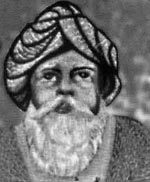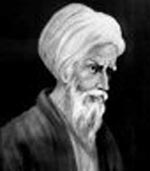
Abu Ali Hasan Ibn
al-Haitham. Also known as ‘Alhazen’
Said to have been
born in Basra, Persia in 965, and to have died in Cairo in 1040
A THOUSAND YEARS AGO THIS OUTSTANDING SCIENTIST:
- Discovered the principle of inertia - 600 years before Galileo
- Developed analytical geometry - 600 years before Descartes
- Discovered the laws of the refraction of light – centuries before Snell and Descartes
- Found that white light is a mix of different colours - anticipating Newton and others
- Was the first to describe accurately
the various parts of the eye, and thereby:
- Became known as the father of modern optics
- Gave a scientific explanation of the process of vision
- Studied magnifying lenses, parabolic and spherical mirrors.
- Made the earliest use of the Camera Obscura
- Studied atmospheric refraction,
whereby he:
- Gave the correct explanation for variations of apparent sizes of the Sun and the Moon as they approach the horizon.
- Discovered that twilight only ceases or begins when the sun is 19° below the horizon.
- Deduced the height of the atmosphere: 55 miles, which is basically correct
- Discussed theories of attraction between masses
- Apparently became aware of the magnitude of acceleration due to gravity
- Wrote a book about evolution – eight centuries before Darwin
After his birth in or near Basrah (present-day Iraq), he was educated in Baah and Baghdad. As a youth, he thought about the conflicting religious views of the various faiths and came to the conclusion that none of them represented the truth. He decided to devote himself entirely to a study of science which he found most clearly described in the writings of Aristotle. He spent his life in Spain – where there were many Arabic people at the time – and in Egypt, researching and writing. Some say Alhazen wrote 92 books, others put the number as high as 200. Some 55 have survived.
The main topics on which he wrote were optics -including a theory of light and a theory of vision – as well as astronomy and mathematics, including geometry and number theory. He conducted research in optics, mathematics, physics, medicine as well as the development of scientific understanding.
In Al-Haitham's writings, one finds a clear explanation of the scientific methods as worked out and applied by the Muslims. He made a major contribution to scientific methodology, as distinct from guesswork. His was a crucial influence in the force placing of scientific study on a solid foundation comprising a systematic relationship between observation, hypothesis and verification.
He wrote an autobiography in 1027, but it concentrates on his intellectual development. There are varying accounts of his biographical details.
According to one story, he pretended to be mad for several years. It is said that he had proposed a plan to control the flooding of the Nile. He was summoned to Egypt by a Caliph – al-Hakim - and appointed head engineer. But he had not anticipated the might of the Nile. He gave up his plans to regulate the flow of water with massive constructions. Now, he had also not anticipated the might of the Caliph, a man who was keen on astronomy and other science, but was also rather fond of slaughter. To avoid the Caliph’s wrath, Alhazen pretended to be mad – for years -remaining confined to his house until the Caliph died in 1021.
It is told that one advantage of this was that throughout that time he was able to continue with his important scientific work, undisturbed. After al-Hakim's death, so the story goes, he was able to show that he had only pretended to be mad.
Apparently he lived out the next 20 years near the Azhar Mosque in Cairo writing mathematics texts, and teaching, on occasion even working as a scribe for extra money.
A seven volume work on optics, Kitab al-Manazir, is considered by many to be ibn al-Haitham's most important work contribution. It was translated into Latin as Opticae Thesaurus Alhazeni in 1270. His aim was "criticising premises and exercising caution in drawing conclusions" while he wished aimed "to employ justice, not follow prejudice, and to take care in all that we judge and criticise that we seek the truth and not be swayed by opinions". He makes it clear that his investigations will be based on experimental evidence rather than on abstract theory.
In his time he had conducted experiments on the propagation of light and colours, optical illusions and reflections, detailing many experiments with spherical segments (glass vessels filled with water). He came very close to discovering the theory of magnifying lenses which was developed in Italy three centuries later. He dealt at length with the theory of various physical phenomena such as sunsets, rainbows, shadows, and eclipses. Roger Bacon (thirteenth century), Pole Witelo (Vitellio) and all Medieval Western writers on Optics base their optical work primarily on Al-Haitham's 'Opticae Thesaurus.'
His work also influenced Leonardo da Vinci and Johann Kepler. In Physics, he studied the mechanics of motion of a body and was the first to propose that a body moves perpetually at constant velocity and in a straight line unless an external force stops it or changes its direction of motion. This is strikingly similar to the first law of motion. It is also a startlingly counter-intuitive insight: we never see this happen on earth.
The ideas contained in his book on evolution are worth reading and useful even today. He wrote commentaries on Aristotle, Galen, Euclid and Ptolemy. Indeed, he contradicted Ptolemy's and Euclid's theory of vision that objects are seen by rays of light emanating from the eyes; according to him the rays originate in the object of vision and not in the eye.
ALHAZEN’S BILLIARD PROBLEM
In 1997, Alhazen’s name was briefly in the news. He had worked extensively on a problem formulated by Ptolemy in A.D. 150. Alhazen wrestled so hard with it that it became known as ‘Alhazen’s Problem’, or even ‘Alhazen’s billiard problem, because the questions it deals with can apply to billiard balls as well as spherical mirrors. It was not solved until more than a thousand years after Alhazen’s death, by an Oxford don in 1997.
It was known as ‘the last great problem of classical geometry’, and for Alhazen it could be posed in this way. Given a light source and a spherical mirror, find the point on the mirror where the light will be reflected to the eye of an observer.
Adapted to become "Alhazen's Billiards Problem", it may also be formulated in this way: How does one find the point on the boundary of a circular billiards table at which the cue ball must be aimed, if it is to hit the cushion and then the black ball? Dr. Peter Neumann, a fellow of Queen’s College, Oxford cracked this riddle, which had baffled mathematicians for a millennium. The great difficulty in the problem lay in the fact that mathematicians envisage spherical mirrors or billiard balls as infinitely small points. Classical ruler-and-compass methods developed by Euclid, the Greek mathematician, were not helpful in this case. They did not provide the means to derive a cube root. Neumann translated the billiards table geometry into co-ordinates on two axes. These may be called X and Y. It was an insight Neumann took from the work of Descartes in the 17th Century.
Then the problem could be tackled using a theory formulated in 1830 by an 18-year-old called Evariste Galois (Incidentally, he died in a duel two years later). Galois's theory in its modern version is the theory of equations as studied by third-year mathematics students. So, once he had arrived at that stage, Dr. Neumann’s work was swiftly done. At the time, Dr. Neumann explained that his proof would have no practical use at all – neither in optics, no billiards, nor – as he put it – " for designing light bulbs, let alone finding the number of people to change them."
Beer and Medler in their famous work Der Mond (1837) mention one of the surface features of the moon named after Alhazen. It is the name of a ring-shaped plain to the west of the hypothetical Mare Crisium in Section No.12.


